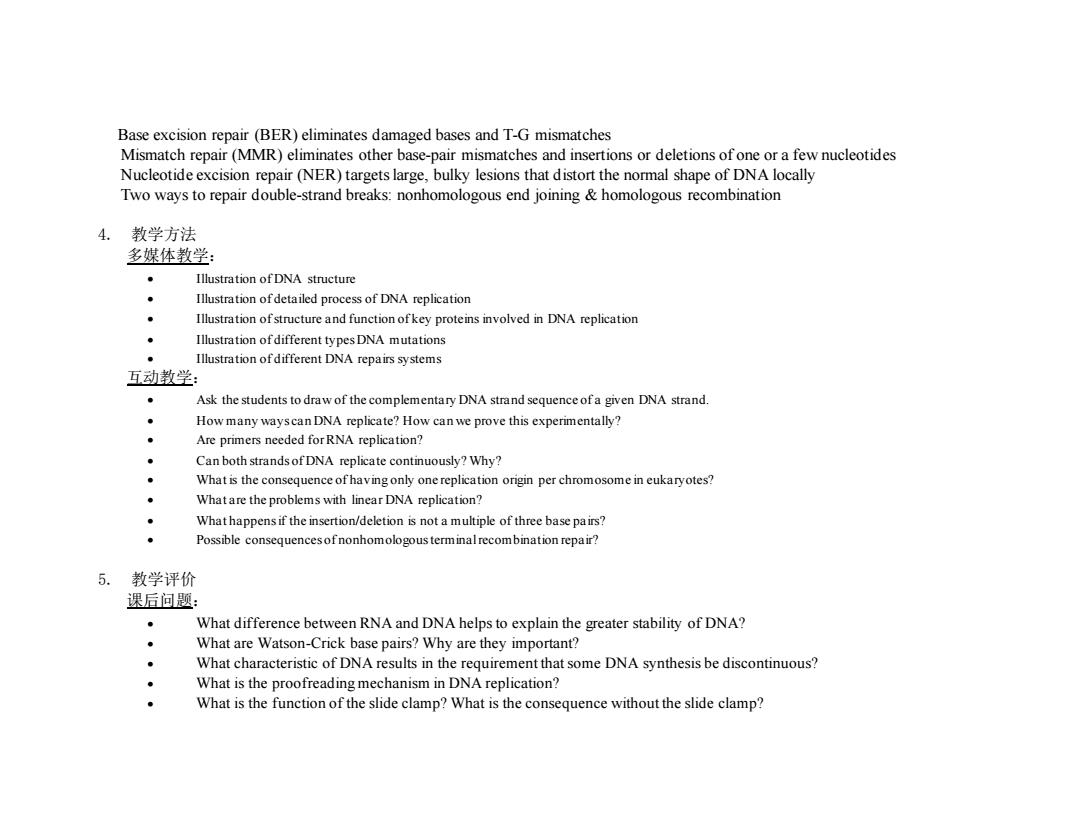正在加载图片...

Base excision repair (BER)eliminates damaged bases and T-G mismatches Mismatch repair(MMR)eliminates other base-pair mismatches and insertions or deletions of one or a few nucleotides Nucleotide excision repair (NER)targets large,bulky lesions that distort the normal shape of DNA locally Two ways to repair double-strand breaks:nonhomologous end joining homologous recombination 4. 教学方法 多媒体教学: Illustration ofDNA structure Illustration ofdetailed process of DNA replication Illustration of structure and function of key proteins involved in DNA replication Illustration ofdifferent types DNA mutations Illustration ofdifferent DNA repairs systems 互动教学: Ask the students to draw of the complementary DNA strand sequence of a given DNA strand. How many wayscan DNA replicate?How can we prove this experimentally? Are primers needed for RNA replication? Can both strands of DNA replicate continuously?Why? What is the consequence of having only one replication origin per chromosome in eukaryotes? Whatare the problems with linear DNA replication? What happens if the insertion/deletion is not a multiple of three base pairs? Possible consequencesofnonhomologous terminal recombination repair? 5. 教学评价 课后问题: What difference between RNA and DNA helps to explain the greater stability of DNA? What are Watson-Crick base pairs?Why are they important? What characteristic of DNA results in the requirement that some DNA synthesis be discontinuous? What is the proofreading mechanism in DNA replication? What is the function of the slide clamp?What is the consequence without the slide clamp?Base excision repair (BER) eliminates damaged bases and T-G mismatches Mismatch repair (MMR) eliminates other base-pair mismatches and insertions or deletions of one or a few nucleotides Nucleotide excision repair (NER) targets large, bulky lesions that distort the normal shape of DNA locally Two ways to repair double-strand breaks: nonhomologous end joining & homologous recombination 4. 教学方法 多媒体教学: • Illustration of DNA structure • Illustration of detailed process of DNA replication • Illustration of structure and function of key proteins involved in DNA replication • Illustration of different types DNA mutations • Illustration of different DNA repairs systems 互动教学: • Ask the students to draw of the complementary DNA strand sequence of a given DNA strand. • How many ways can DNA replicate? How can we prove this experimentally? • Are primers needed for RNA replication? • Can both strands of DNA replicate continuously? Why? • What is the consequence of having only one replication origin per chromosome in eukaryotes? • What are the problems with linear DNA replication? • What happens if the insertion/deletion is not a multiple of three base pairs? • Possible consequences of nonhomologous terminal recombination repair? 5. 教学评价 课后问题: • What difference between RNA and DNA helps to explain the greater stability of DNA? • What are Watson-Crick base pairs? Why are they important? • What characteristic of DNA results in the requirement that some DNA synthesis be discontinuous? • What is the proofreading mechanism in DNA replication? • What is the function of the slide clamp? What is the consequence without the slide clamp?